The fashionable trend of recent years in the interior is flowers from isolon. Making such beauty with your own hands is not at all as difficult as it seems at first glance. The main thing is to know the special properties of the material and a simple algorithm for creating a flower. A small review from HouseChief is devoted to this very topic.
Read in the article
- 1 Izolon: what is it, its use for interior colors
- 2 Features of isolon, how to choose it for flower arrangements
- 3 Isolon basics
- 4 Simple workshops on assembling flowers from isolon
- 4.1 Master class: flowers from a fancy shape isolon
- 4.2 How to make a large chamomile from Isolone
- 4.3 Peony on a plafond of a table lamp
- 4.4 We make bright lilies from isolon
- 4.5 How to collect a growth rose
- 4.6 A little sun in every home: Isolon sunflower
- 4.7 Video master class: rose-lamp from isolon
- 5 How much is an isolon for flowers: the price of the issue
Izolon: what is it, its use for interior colors
There was a time when artificial flowers were associated with something tasteless and cheap. But now, when materials and technologies have almost reached perfection, this opinion is no longer relevant. Artificial flowers, especially handmade, have become an exquisite interior decoration not only on special occasions, but also in everyday life.
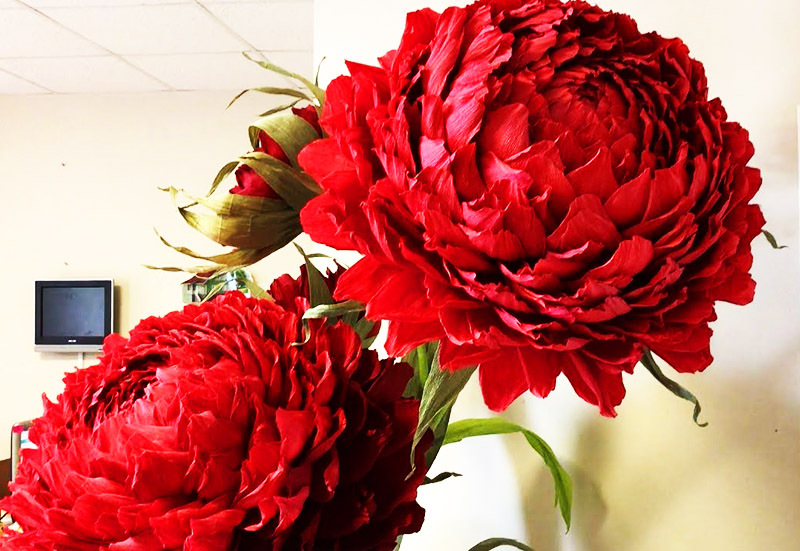
How to choose the right material and make a flower arrangement so that you get a real masterpiece? So, izolon, what is this material for making interior flowers? You may encounter him in a building materials store, but don't be surprised. Indeed, izolon is widely used for thermal insulation in a wide variety of places: from floors to roofs. And this does not prevent him from becoming one of the most demanded materials for needlework.
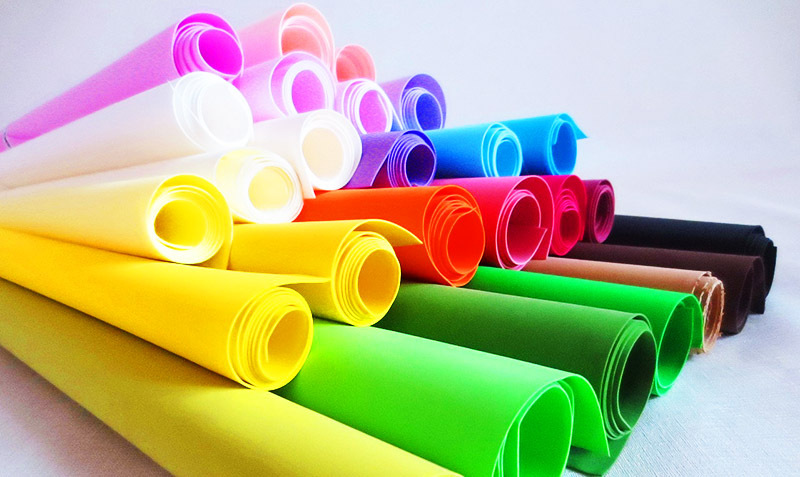
What is the difference between izolon for needlework and construction? It has three main differences: thickness, density and decorative colors. But in terms of its composition and properties, it is still the same foamed polyethylene or PPE. Under this abbreviation, you can find it on sale. It can be distinguished by the presence of embossing or a velvety surface.
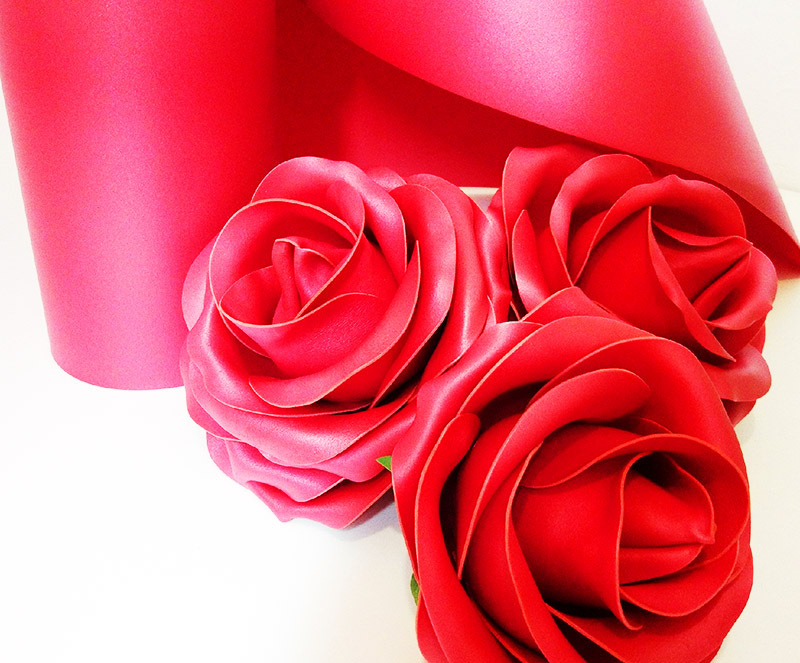
Features of isolon, how to choose it for flower arrangements
Izolon has its positive properties and negative sides that you need to know about in order to avoid failure. But first about the merits:
- the material is very dense and tear-resistant;
- Izolon is easily cut with scissors and a stationery knife;
- Isolone products are hypoallergenic and safe, including for children;
- the material is very light, products from it are literally airy;
- mold does not settle on the isolone, microbes and fungi do not develop, it does not support combustion, has no foreign smell;
- the products are well painted, and its parts are reliably glued to each other and to other materials.
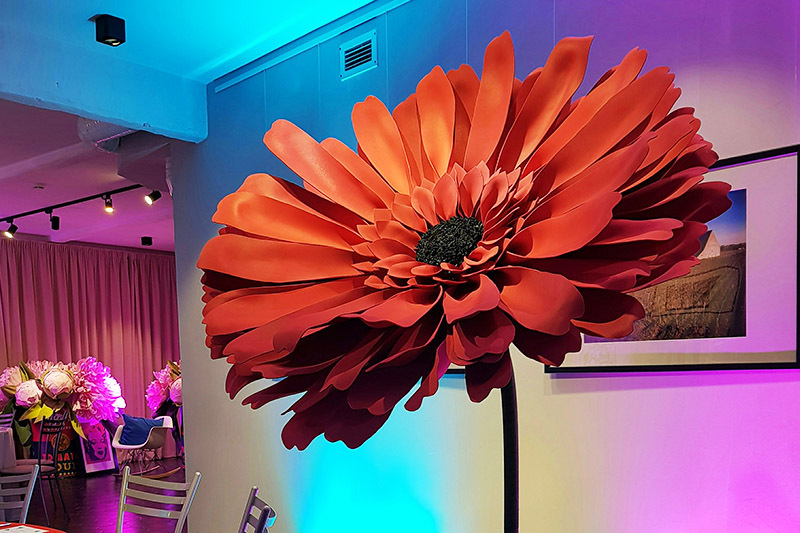
But what features of the isolon are worth remembering:
- material should be carefully selected; not all options are suitable for creating flowers;
- finished products are able to attract dust due to static electricity, so you will have to periodically treat them with an antistatic agent;
- to work with this material, you will need a special tool - a building hair dryer.
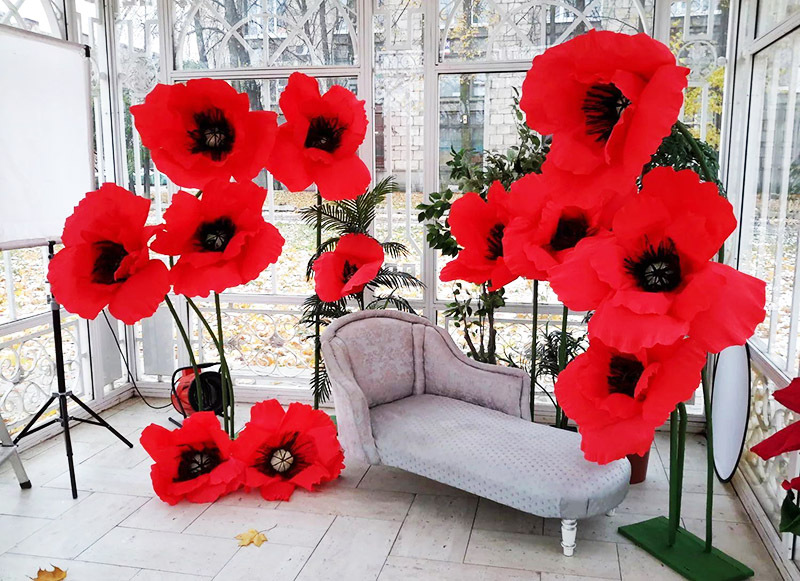
What should you pay attention to when choosing a material if you are going to make interior flower arrangements with your own hands?
First of all, remember that not every isolone is suitable for this purpose. By the way, you may even come across a fake that is not suitable for needlework. And one more important point: do not confuse isolon and foamiran. Even sellers often do this, but these materials have a different basis. Isolone has polyethylene, and foamiran has ethyl vinyl acetate.
Isolon, suitable for handicrafts, has a smooth surface and high elasticity. Pay attention to the marking: the most suitable are PPE-R, PPE-F, PPE NR and Izolon 500.
For your information! Materials with the name Penolon or Aksalut are not isolon and are inferior in quality.
If you are going to make growth flowers, then you will need an isolon 1 m wide, large petals can be cut out of such material.
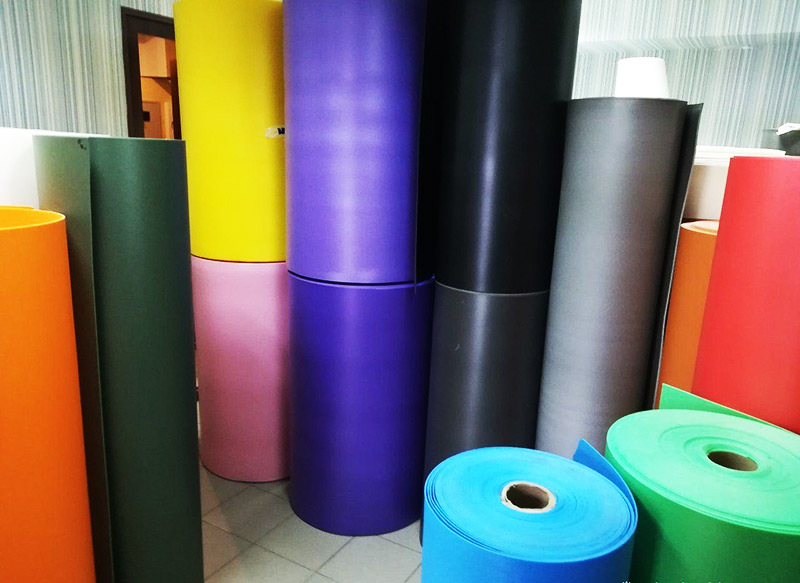
Color is not a selection criterion. The color gamut of the isolon for needlework is very wide, in addition, if necessary, you can tint it with pastels.
When choosing, the density of the material may matter. For a beginner craftsman, an isolon with a density of 33 kg / m³ will be the best choice. Later you will learn to work with both more and less dense formulations.
Isolon basics
The most important thing in creating a flower is to think carefully about its shape. It is not at all necessary to start from real plants: fantasy compositions are much more interesting.
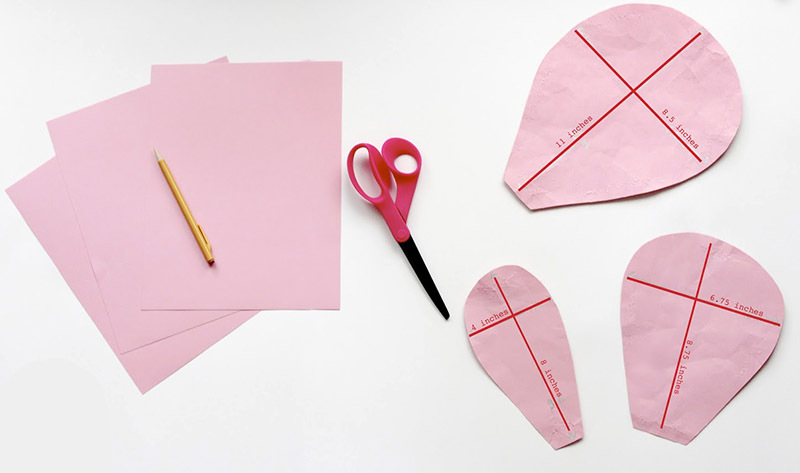
For your information! White isolon can turn yellow in direct sunlight, so these flowers are best placed in the shade.
To make petals and leaves, you need templates. Ready-made options can be downloaded online or made yourself using paper or cardboard.
To add volume to each petal, the workpiece is heated and stretched by hand.
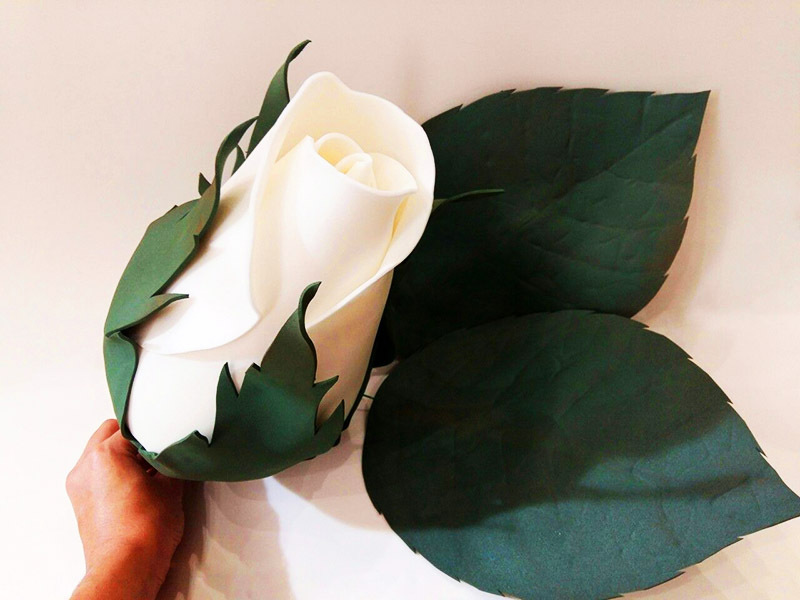
Flower sizes may vary. It all depends on your idea. You can put together a life-size composition or make a decoration on a table or wall. The larger the flower, the thicker the material for its manufacture must be. The exception is peonies - they have a lot of petals, and they should be thin.
Advice! For maximum realism, study the flower you want to reproduce, or even better, disassemble it into petals so that you have an idea of the size and amount of details needed.
Each type of flower has its own rules. For example, to create a rose, you should start by twisting the petals of a bud around a ball; poppies are made on a solid flat base. Before tackling a large flower, it is better to try to collect its small analogue.
The stem of the plant must have a solid base for sustainability.
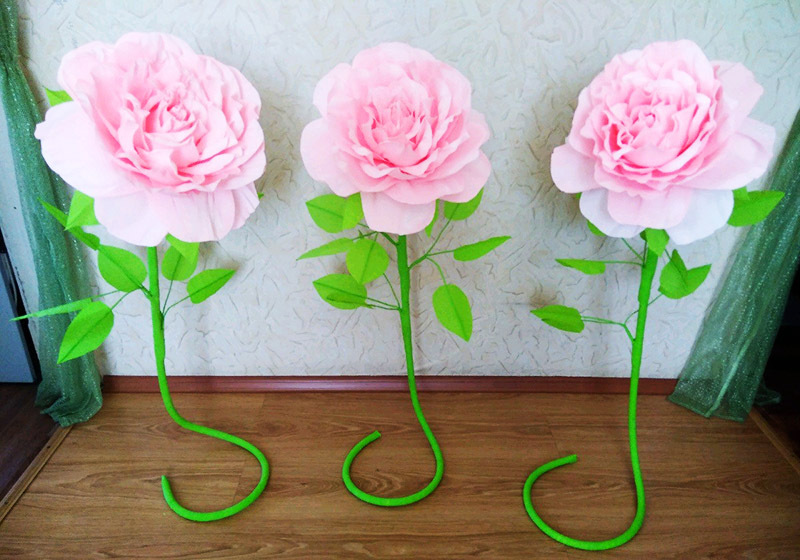
Such a barrel can be decorated with green tape or colored tape, you can simply apply paint. And so that the stem is not empty and bare, leaves from the same isolone are attached to it. They are made in the same way as petals, cutting out according to a pattern and deforming when heated.
If you decide to paint your product, remember that not all paint is suitable for this purpose. You can use acrylic or rubber compound. These paints will not crack over time on a soft base like all others. Spray application is most convenient.
Finally, you need a stable stand for the growth flower. It can be made from an ordinary flower pot, weighing it down with stones or cement.
Simple workshops on assembling flowers from isolon
There is nothing difficult in working with isolon. You will understand this literally from the first experience. Let's start with the simplest: how to make flowers from isolon for beginners? From tools you will need:
- sharp scissors or a utility knife;
- cardboard or paper for templates;
- building hair dryer or iron with the possibility of minimum heating;
- glue gun or glue suitable for gluing polyethylene products;
- stand and tube for the stem.
Master class: flowers from a fancy shape isolon
It is not at all difficult to make a fantasy lotus flower from an isolone, you just need to think over the shape of the petals. Here's a sample master class:
| Illustration | Description of action |
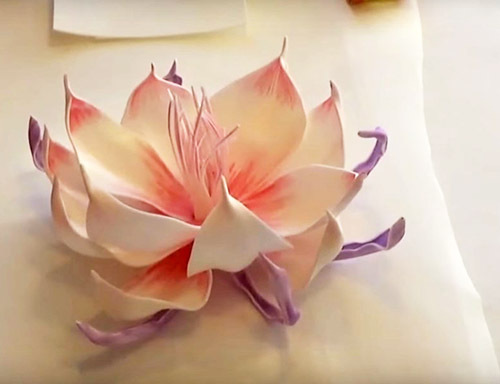 | To make such a flower, you need white isolon, paints, scissors, a hot hair dryer and glue. |
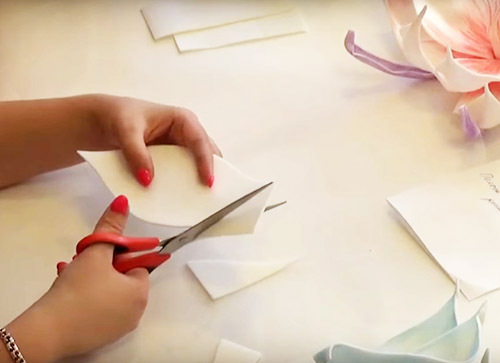 | Cut the petals from izolon according to your own template |
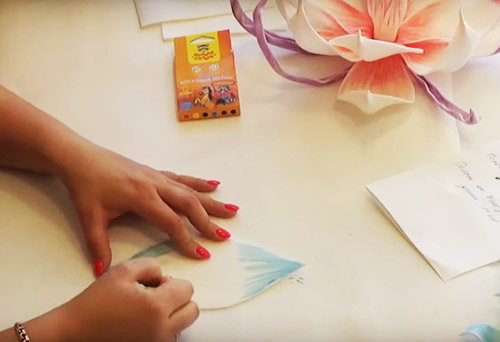 | Give each petal a shade all over or at the edges |
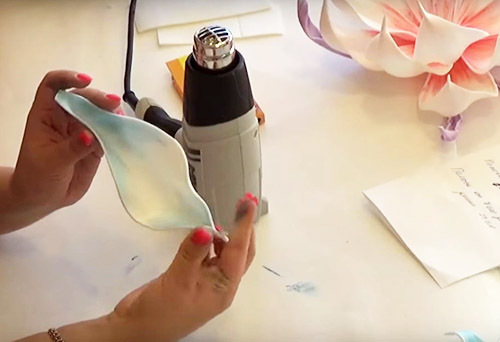 | Heat the petal with a hot hair dryer and pull it out so that it takes the desired shape |
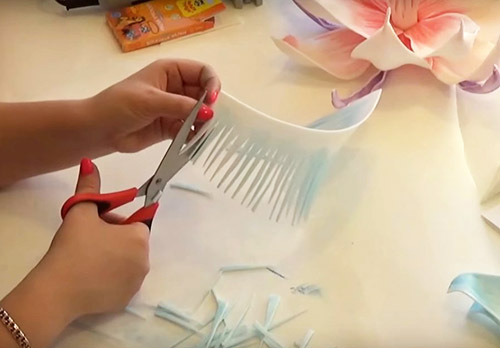 | Cut a strip of isolon about 20-30 cm long with a fringe |
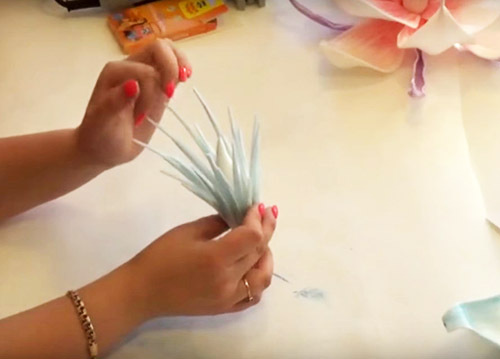 | Tint it and roll it around a pestle of the same material. |
 | Apply hot glue to the base of the petal and glue to the finished center |
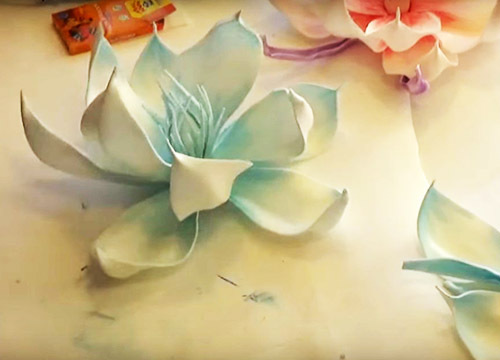 | Collect the flower in several layers of petals. The more there are, the more magnificent the result will be. |
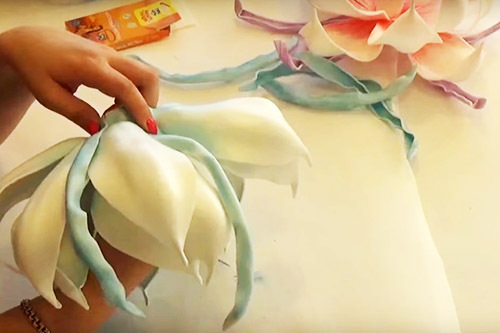 | Top off the inflorescence with thin sepals at the base. |
How to make a large chamomile from Isolone
Chamomiles are simple flowers that are always pleasing to the eye. If you make growth plants, they will ideally decorate the photo zone. A sample is provided in this free algorithm:
| Illustration | Description of action |
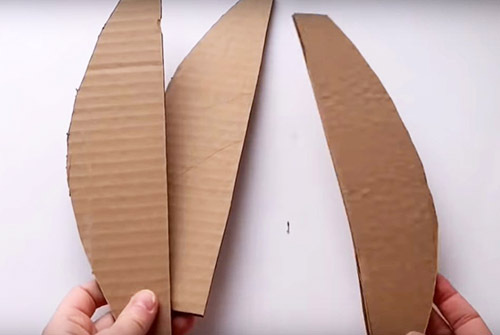 | To give the chamomile petals a foma, you need to make a volumetric template. For him you need to cut three cardboard blanks |
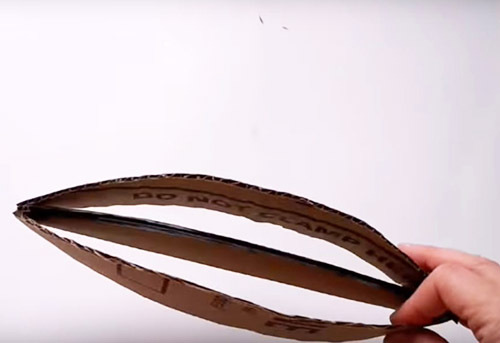 | They need to be combined into such a template, and the edges of the cardboard should be sealed with electrical tape so that they do not leave clear marks on the isolone |
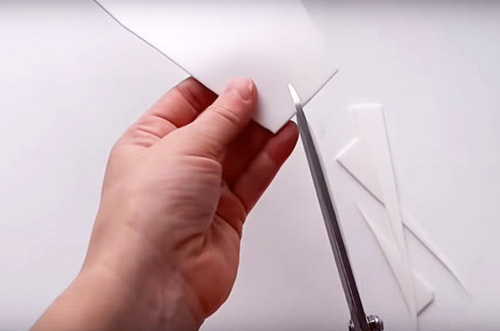 | Cut the isolon into petals according to the template |
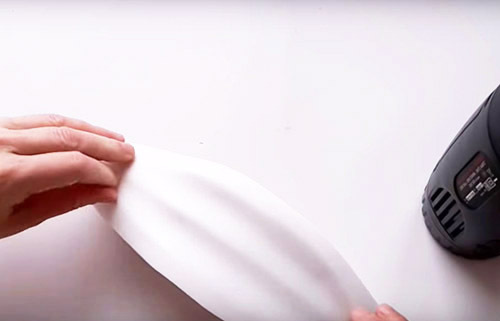 | Heat the material on a hot hair dryer and apply to the template. Stretch and squeeze the isolon slightly so that the relief appears on it. |
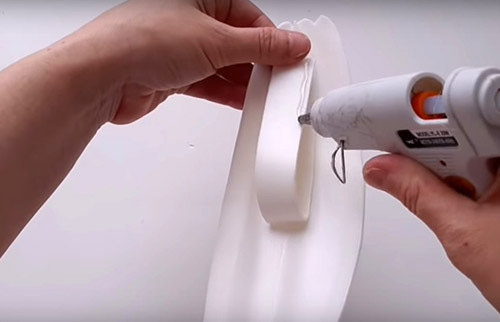 | On the inside of the petal, glue a strip of isolon about 2 cm wide |
 | Pass a piece of wire through this "channel" - it will allow each petal to have a clear and rigid shape |
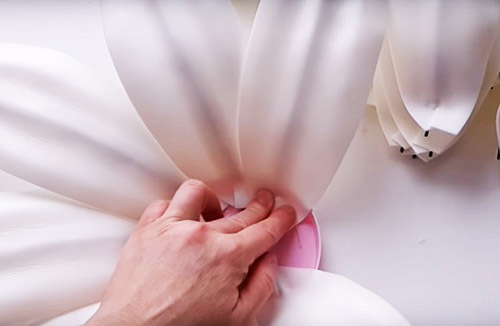 | Choose a round base for the flower - this could be a plastic plate. Glue petals to it in 2 rows |
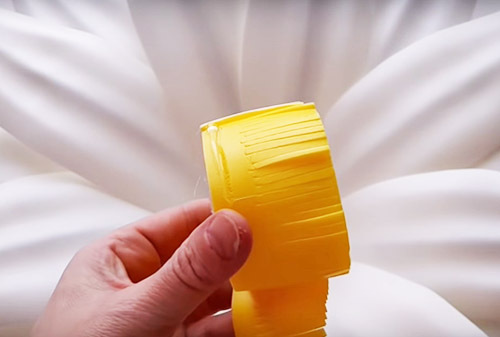 | Cut a yellow isolone 5 cm wide and about 150 cm long into the fringe. Roll it up, gluing the edge |
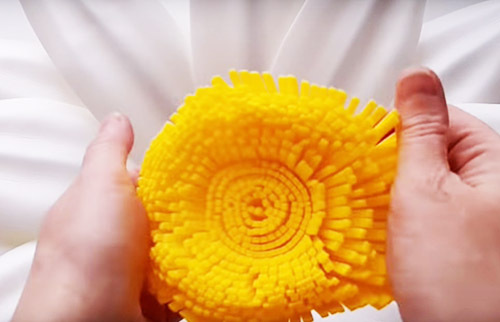 | To make the middle of the chamomile look natural, fluff it up with your hands, slightly stretching the edges. |
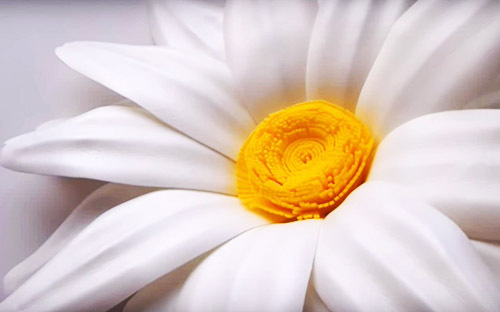 | It remains only to insert the middle into the center of the flower - and the growth chamomile is ready |
Peony on a plafond of a table lamp
Various izolon lamps are very popular now. You can make such a lighting device from an ordinary table lamp with a round shade. To make a peony from isolone, we suggest that you consider the given master class:
| Illustration | Description of action |
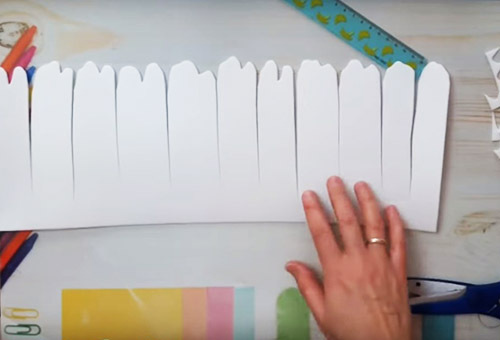 | Prepare 4 wide strips and cut them as shown in the photo |
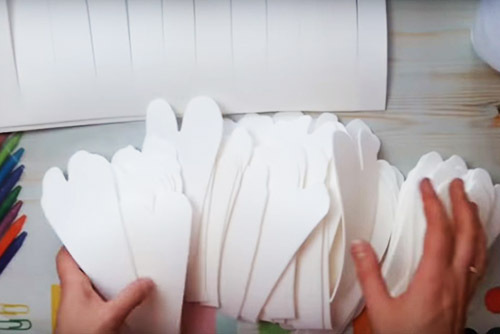 | The second type of petals is single. Their size is slightly larger than the first |
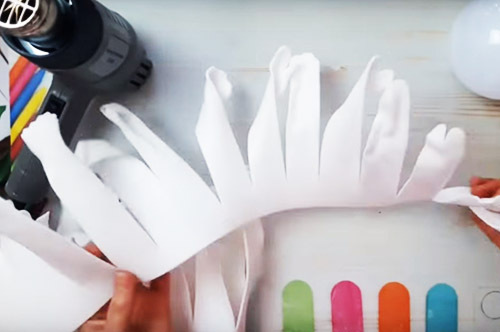 | Heat and twist the thinnest petals to shape |
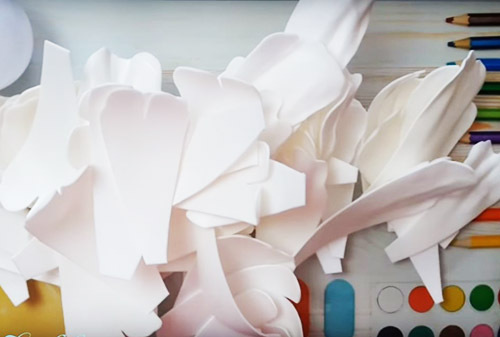 | Give the petals of the second row a semicircular relief and slightly stretch the edges. |
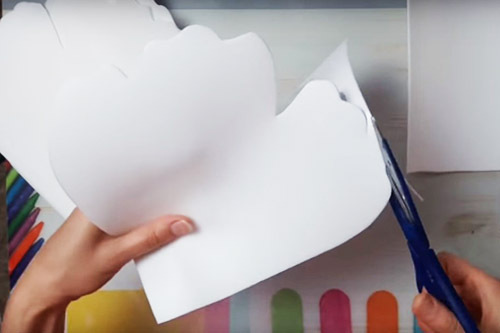 | The third row of petals at the very base consists of the largest elements |
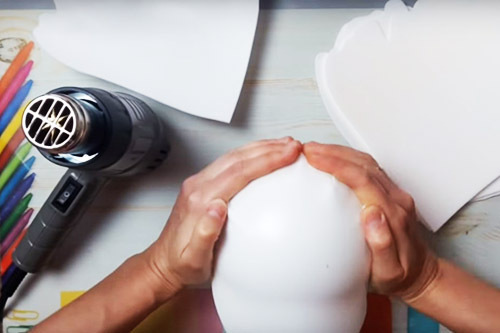 | Each such large petal needs to be heated and shaped by pulling it over a spherical template |
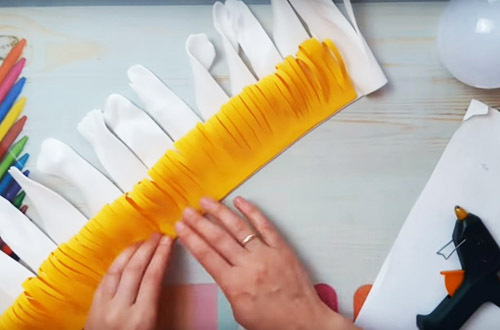 | Prepare a yellow fringe, combine it with the thinnest petals |
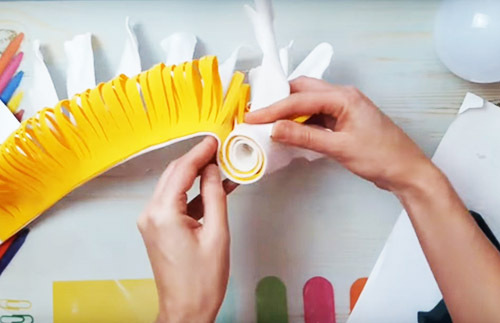 | Roll the petals together with the fringe on a roll and glue |
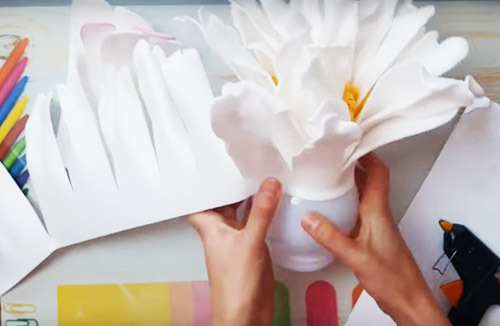 | Continue wrapping the flower, securing it as a base on the lamp shade |
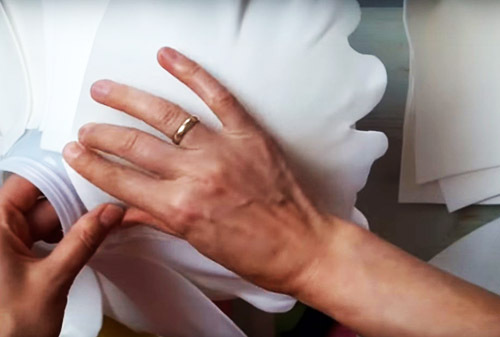 | Glue the second and largest petals in a circle in several rows |
 | The flower is almost ready, it already looks like a real one |
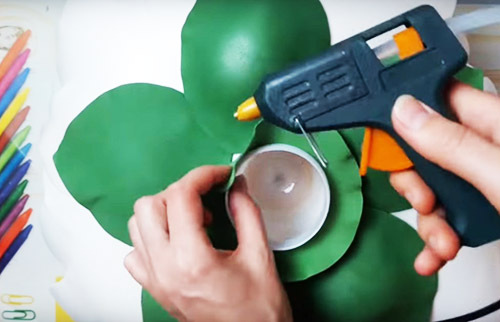 | Glue the green sepals underneath |
We make bright lilies from isolon
Lily is an exquisite flower of not too complex shape. It's pretty simple to make it:
| Illustration | Description of action |
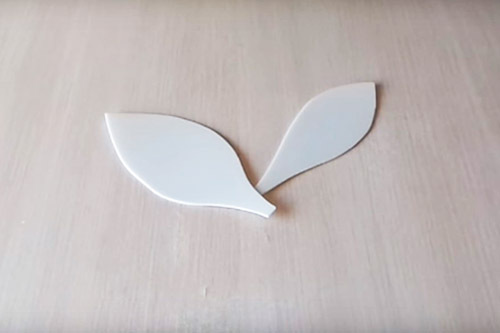 | To make a lily, you will need 3 large and slightly smaller petals. |
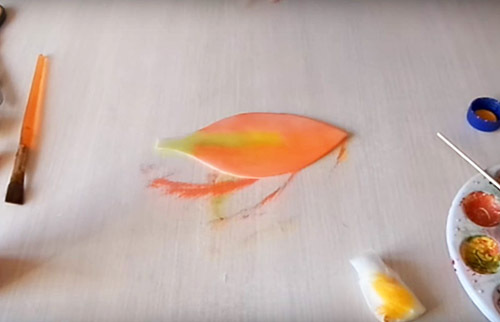 | Tint them with acrylics using several shades - greenish at the base, yellow at the center and pink or orange at the tip. |
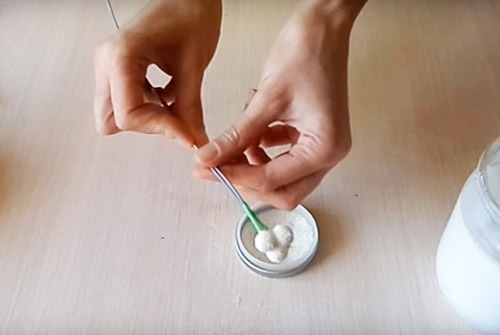 | You can make a lily pestle yourself from wire, styrofoam and semolina |
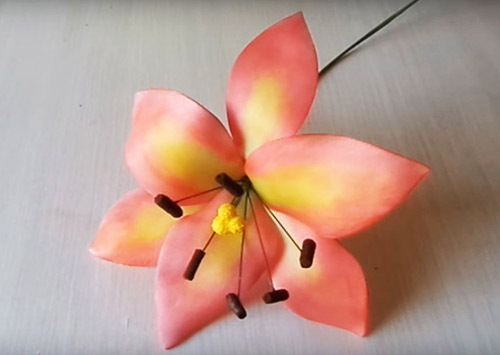 | It is better to buy stamens ready-made, they are sold in stores for needlework |
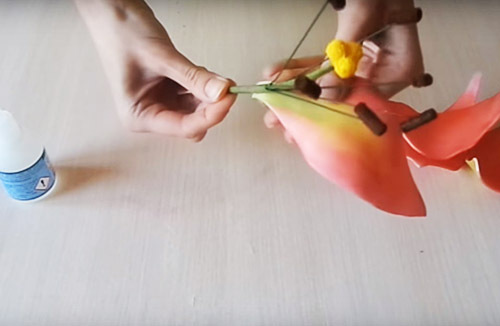 | Gather the petals around the center with hot glue |
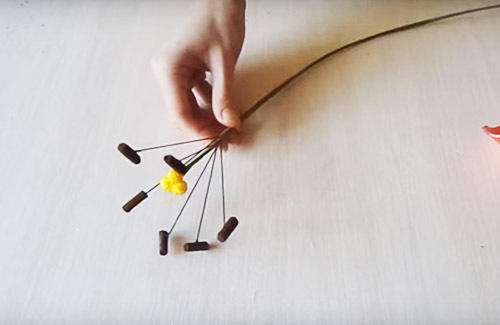 | The lily is ready, in a bouquet several of these flowers will look great |
How to collect a growth rose
Roses are the most favorite flowers for many, so the decoration with this particular flower is most often found in the interior. How to make a growth rose from an isolone in this master class:
| Illustration | Description of action |
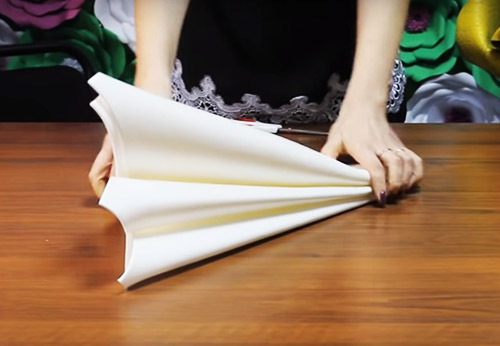 | Fold a square piece of isolon into a triangle |
 | Cut the material so that you have 4 large petals connected in the center. You will need at least 8 of these blanks |
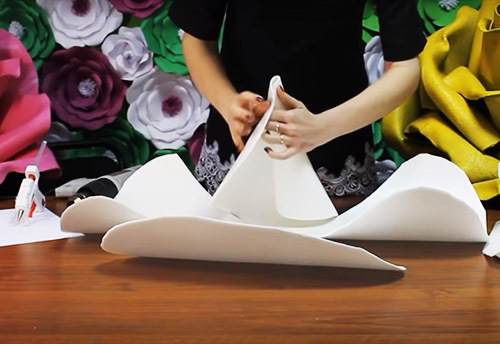 | Roll the first workpiece into a tight bud, holding the petals with hot glue |
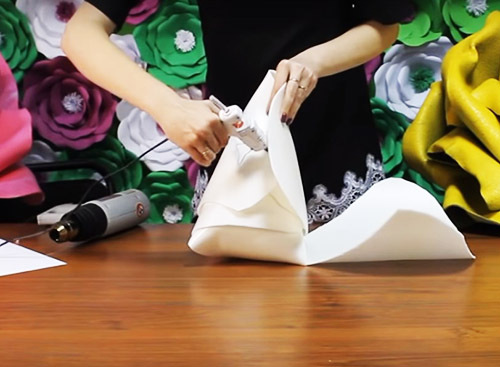 | Roll so that the edges of all petals are visible from above |
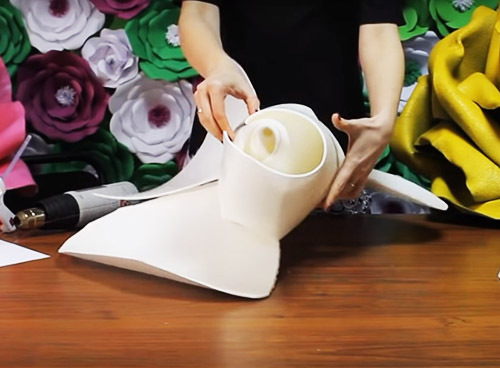 | Place the bud on the second blank, glue them in the center and continue to fold, giving a little freedom to the petals. |
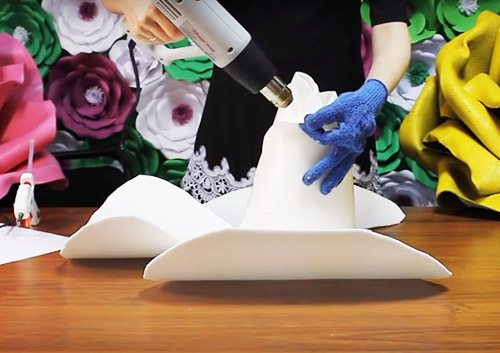 | Starting with the second row, stretch the edges of the petals with a hot hair dryer and roll them outward. |
 | Fasten all 8 blanks in this way, gradually dissolving the rose |
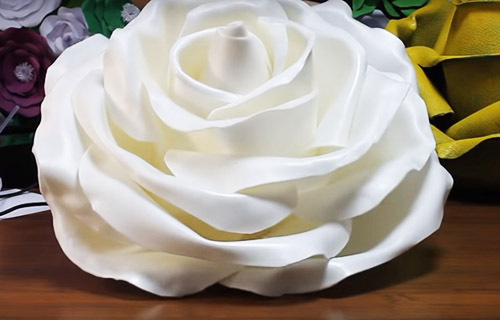 | The flower is ready, you can attach it to the stem stand |
A little sun in every home: Isolon sunflower
Sunflowers are bright and cheerful flowers that do not last long in the cut. But you can put a do-it-yourself sunflower from an isolon at home:
| Illustration | Description of action |
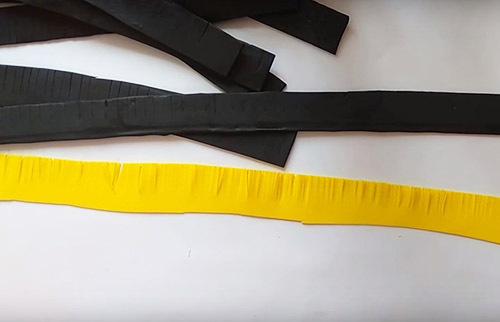 | The center of the flower will consist of stripes of yellow and black fringes. More shades can be used by adding brown and green |
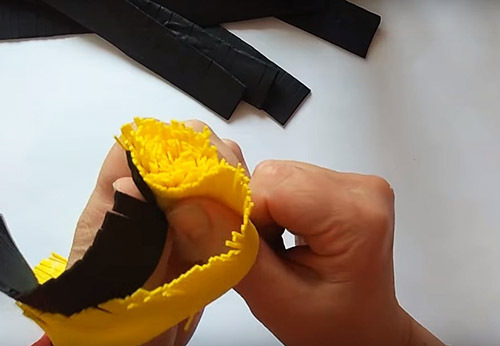 | Take a piece of plastic pipe as a base and wrap the fringe around, and insert a tassel in the center so that there is no void |
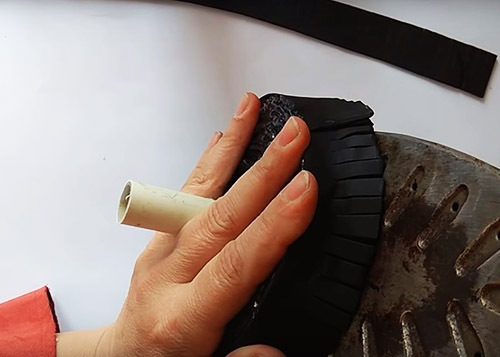 | Fluff the slightly finished core by heating it with a hairdryer or a warm iron |
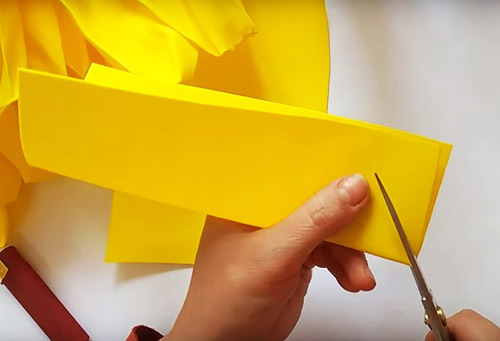 | Prepare petals from yellow isolon |
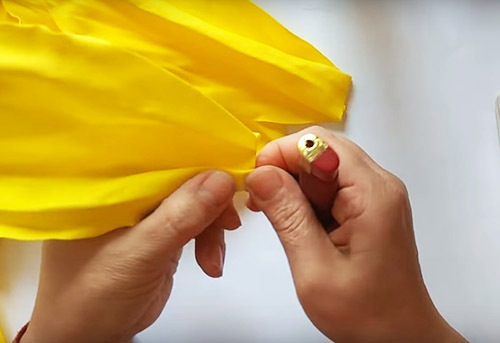 | Give each petal a volumetric shape |
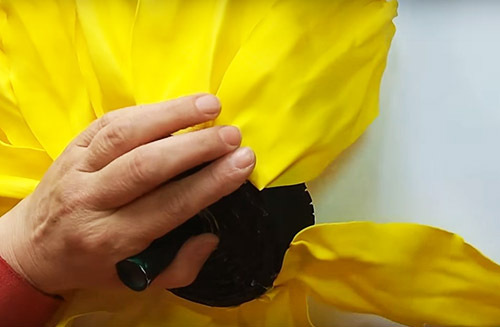 | Glue the core with petals in several rows in a circle |
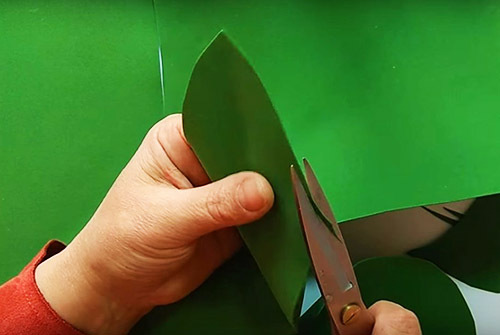 | Make sepals from green material |
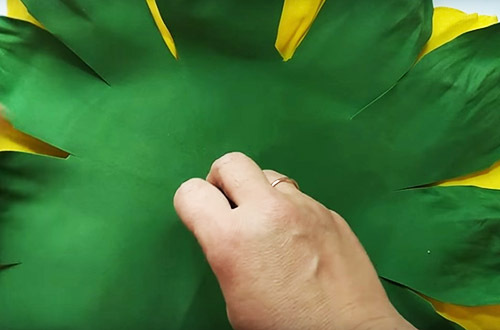 | Hide the base of the flower behind the sepals |
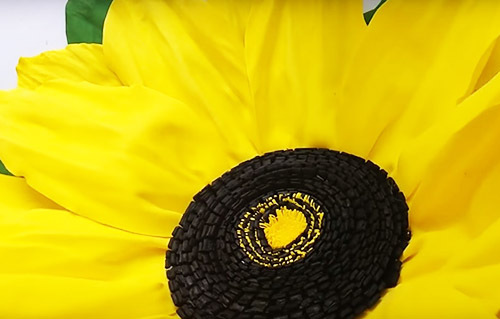 | A sunflower will be a decoration for a home or a trading floor. |
Video master class: rose-lamp from isolon
Growth flowers can simply be used to decorate the photo zone, or you can collect interior lamps from them. How to do this - in this popular video master class on growth flowers from isolon:
How much is an isolon for flowers: the price of the issue
It remains only to clarify one question: what are the costs of such needlework? An ordinary white isolon 2 mm thick costs from 70 rubles per square meter with a width of 75 cm. The thicker the material, the more expensive it is. The three-millimeter one will cost from 120 rubles. And now simple arithmetic: a rose floor lamp made of such material costs from 3,500 rubles. And it will require, if you remember, 8 squares, that is, approximately 6 m of isolon and the cost of a piece of pipe for the stem and the electrical part. In total, you get no more than 1200 rubles. Therefore, in any case, you will not be left at a loss, but you will acquire a unique interior decoration and get great pleasure from the process itself.
How did you like this idea? Write in the comments which flower you would like to try to make or have already done? What came of it? Subscribe to our newsletter and keep abreast of all the latest news in this direction!


